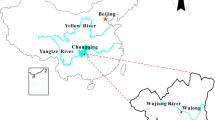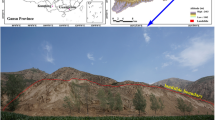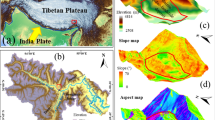Abstract
Runout prediction and deposit characteristics investigation for the long runout rock landslides are challenging and interesting problems nowadays. On a practical level, the landslide is a critical issue around the world which could lead to catastrophic consequences. One of the current typical instances is the successive Baige landslides in Tibet, China, where massive damages to infrastructure constructions led to evacuation of more than 86,000 people. The work is specially aimed at investigating the dynamic behaviors of the long runout rock landslides and predicting the potential impact region by numerical simulations. The focus is on the representation of the interaction between the constituent blocks and macro-scale response of landslides. In this case, the distance potential-based discrete element method is adopted to solve the above problems and reproduce the sliding process of the Baige landslides. Before applied in modeling the Baige landslides, performances of this method are firstly validated by two well-known benchmark experiments. The simulation results agree well with the existing experimental measurements and reported observations. It is proved that the method could predict a quantitative accumulation area of related landslides and provide a reference of hazard mitigation.


















Similar content being viewed by others
References
Alejano LR, Gonzalez J, Muralha J (2012) Response by the authors to S. R. Hencher's discussion of the paper comparison of different techniques of tilt testing and basic friction angle variability assessment. Rock Mech Rock Eng 45:1141–1143
Alejano LR, Sanchez-Alonso C, Perez-Rey I et al (2018) Block toppling stability in the case of rock blocks with rounded edges. Eng Geol 234:192–203
Bandara S, Soga K (2015) Coupling of soil deformation and pore fluid flow using material point method. Comput Geotech 63:199–214
Bao HR, Zhao ZY (2012) The vertex-to-vertex contact analysis in the two-dimensional discontinuous deformation analysis. Adv Eng Softw 45:1–10
Chen K-T, Wu J-H (2018) Simulating the failure process of the Xinmo landslide using discontinuous deformation analysis. Eng Geol 239:269–281
Crosta GB, Imposimato S, Roddeman D (2009) Numerical modelling of entrainment/deposition in rock and debris-avalanches. Eng Geol 109:135–145
Cundall PA (1988) Formulation of a three-dimensional distinct element model - part i. A scheme to detect and represent contacts in a system composed of many polyhedral blocks. Int J Rock Mech Min Sci Geomech Abstr 25:107–116
Cundall PA, Owen DRJ (1979) A discrete numerical model for granular assemblies. Geotechnique 29:47–65
Fan XM, Xu Q, Alonso-Rodriguez A, Subramanian SS, Li W, Zheng G, Dong X, Huang R (2019) Successive landsliding and damming of the Jinsha River in eastern Tibet, China: prime investigation, early warning, and emergency response. Landslides 16:1003–1020
Hart R, Cundall PA, Lemos J (1988) Formulation of a three-dimensional distinct element model - part ii. Mechanical calculations for motion and interaction of a system composed of many polyhedral blocks. Int J Rock Mech Min Sci Geomech Abstr 25:117–125
Hirt CW, Amsden AA, Cook JL (1997) An arbitrary Lagrangian-Eulerian computing method for all flow speeds. J Comput Phys 135:203–216
Hoek E, Bray JW (1977) Rock slope engineering. The Institution of Mining and Metallurgy, London
Li H-b, Qi S-c, Chen H et al (2019) Mass movement and formation process analysis of the two sequential landslide dam events in Jinsha River, Southwest China. Landslides 16:2247–2258
Llano-Serna MA, Farias MM, Pedroso DM (2016) An assessment of the material point method for modelling large scale run-out processes in landslides. Landslides 13:1057–1066
Longo A, Pastor M, Sanavia L, Manzanal D, Martin Stickle M, Lin C, Yague A, Tayyebi SM (2019) A depth average SPH model including mu(I) rheology and crushing for rock avalanches. Int J Numer Anal Methods Geomech 43:833–857
Lucy LB (1977) A numerical approach to the testing of the fission hypothesis. Astron J 82:1013–1024
Mahabadi OK, Lisjak A, Munjiza A, Grasselli G (2012) Y-geo: new combined finite-discrete element numerical code for geomechanical applications. Int J Geomech 12:676–688
Manzella I, Labiouse V (2013) Empirical and analytical analyses of laboratory granular flows to investigate rock avalanche propagation. Landslides 10:23–36
Mao J, Zhao LH, Di YT et al (2020a) A resolved CFD-DEM approach for the simulation of landslides and impulse waves. Comput Methods Appl Mech Eng:359
Mao J, Zhao LH, Liu XN, Avital E (2020b) A resolved CFDEM method for the interaction between the fluid and the discontinuous solids with large movement. Int J Numer Methods Eng 121:1738–1761
Munjiza A (2004) The combined finite-discrete element method. Wiley & Sons, England
Munjiza A, Owen DRJ, Bicanic N (1995) A combined finite-discrete element method in transient dynamics of fracturing solids. Eng Comput 12:145–174
Ng CWW, Choi CE, Koo RCH, Goodwin GR, Song D, Kwan JSH (2018) Dry granular flow interaction with dual-barrier systems. Geotechnique 68:386–399
Onate E, Idelsohn SR, Del Pin F et al (2004) The particle finite element method—an overview. International Journal of Computational Methods 1:267–307
Ouyang CJ, An HC, Zhou S, Wang Z, Su P, Wang D, Cheng D, She J (2019) Insights from the failure and dynamic characteristics of two sequential landslides at Baige village along the Jinsha River, China. Landslides 16:1397–1414
Pastor M, Blanc T, Haddad B, Petrone S, Sanchez Morles M, Drempetic V, Issler D, Crosta GB, Cascini L, Sorbino G, Cuomo S (2014) Application of a SPH depth-integrated model to landslide run-out analysis. Landslides 11:793–812
Pastor M, Blanc T, Haddad B, Drempetic V, Morles MS, Dutto P, Stickle MM, Mira P, Merodo JAF (2015) Depth averaged models for fast landslide propagation: mathematical, rheological and numerical aspects. Archives of Computational Methods in Engineering 22:67–104
Shi GH (1991) Manifold method of material analysis. Transaction of the 9th Army conference on applied mathematics and computing, U.S. Army Research Office, Minneapolis, Minnesota, pp 57-76
Shi GH (2001) Three-dimensional discontinuous deformation analysis. The forth International Conference on Analysis of Discontinuous Deformation, Glasgow, Scotland, UK, pp 1-21
Shi GH, Goodman RE (1985) Two dimensional discontinuous deformation analysis. Int J Numer Anal Methods Geomech 9:541–556
Smoljanovic H, Zivaljic N, Nikolic Z et al (2018) Numerical analysis of 3D dry-stone masonry structures by combined finite-discrete element method. Int J Solids Struct 136:150–167
Sulsky D, Chen Z, Schreyer HL (1994) A particle method for history-dependent materials. Comput Methods Appl Mech Eng 118:179–196
Trong Nhan D, Wu J-H (2020) Simulating a mining-triggered rock avalanche using DDA: a case study in Nattai North, Australia. Eng Geol:264
Vyazmensky A, Stead D, Elmo D, Moss A (2010) Numerical analysis of block caving-induced instability in large open pit slopes: a finite element/discrete element approach. Rock Mech Rock Eng 43:21–39
Wang SN, Xu WY, Shi C, Chen HJ (2017) Run-out prediction and failure mechanism analysis of the Zhenggang deposit in southwestern China. Landslides 14:719–726
Wu J-H, Lin W-K, Hu H-T (2017) Assessing the impacts of a large slope failure using 3DEC: the Chiu-fen-erh-shan residual slope. Comput Geotech 88:32–45
Wu J-H, Lin W-K, Hu H-T (2018) Post-failure simulations of a large slope failure using 3DEC: the Hsien-du-shan slope. Eng Geol 242:92–107
Yan CZ, Zheng H (2017) A new potential function for the calculation of contact forces in the combined finite-discrete element method. Int J Numer Anal Methods Geomech 41:265–283
Zhang Z, He SM, Liu W, Liang H, Yan S, Deng Y, Bai X, Chen Z (2019a) Source characteristics and dynamics of the October 2018 Baige landslide revealed by broadband seismograms. Landslides 16:777–785
Zhang LM, Xiao T, He J, Chen C (2019b) Erosion-based analysis of breaching of Baige landslide dams on the Jinsha River, China, in 2018. Landslides 16:1965–1979
Zhao LH, Liu XN, Mao J, Xu D, Munjiza A, Avital E (2018a) A novel discrete element method based on the distance potential for arbitrary 2D convex elements. Int J Numer Methods Eng 115:238–267
Zhao LH, Liu XN, Mao J, Xu D, Munjiza A, Avital E (2018b) A novel contact algorithm based on a distance potential function for the 3D discrete-element method. Rock Mech Rock Eng 51:3737–3769
Acknowledgments
This work is supported by the National Key R&D Program of China (Grant 2018YFC0406705), China Postdoctoral Science Foundation Funded Project (Grant 2019M651677), the 15th Fok Ying-Tong Education Foundation for Young Teachers in the Higher Education Institutions of China (Grant 151073), the Priority Academic Program Development of Jiangsu Higher Education Institutions (Grant YS11001), the 111 Project, and Qing Lan Project.
Author information
Authors and Affiliations
Corresponding author
Rights and permissions
About this article
Cite this article
Mao, J., Liu, X., Zhang, C. et al. Runout prediction and deposit characteristics investigation by the distance potential-based discrete element method: the 2018 Baige landslides, Jinsha River, China. Landslides 18, 235–249 (2021). https://doi.org/10.1007/s10346-020-01501-8
Received:
Accepted:
Published:
Issue Date:
DOI: https://doi.org/10.1007/s10346-020-01501-8




